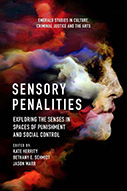Sensory Penalties: Exploring the Senses in Spaces of Punishment and Social Control

Editors: Kate Herrity, Bethany E. Schmidt and Jason Warr
Publisher: Emerald Publishing Limited, 2021. 296 pages.
Reviewer: Lambros Fatsis ǀ March 2022
“Crime” and punishment excite strong feelings, but are rarely associated with the senses. This is also true of the state’s penal institutions. Spaces of punishment are commonly seen as rational bureaucracies that administer “justice”, impose sanctions, and practice social control through dry legal procedures. Yet, this is not all that places of confinement are. They are also ensembles of rich sensory activity orchestrated by those who spend time inside them. Sensory Penalties attunes us to this realisation, inviting readers to think with our senses about how social life is conducted inside penal institutions — be they prisons, detention centres, probation hostels, courtrooms or public spaces that are patrolled, surveilled and controlled. In so doing, this volume’s contributors share insights from their ethnographic research— revealing the lived sensory dimensions of penalties and calling for a sensory approach to criminological scholarship.
Composed of four parts, this tantalising volume aims at defending ‘the role of sensory experience in the production of knowledge’ (p. xxi) through ‘making sense of the sensory’ (Part I), ‘sensing the field’ (Part II), ‘subverting the senses’ (Part III) and offering ‘sensory reflections’ (Part IV). What connects these four parts are ‘three interlocking themes’ (p. xxii). The first two approach the political, symbolic and ideological dimensions of penalty as embedded in ‘places and processes of punishment and social control’, but also ‘encoded’ in the senses, as receptacles of such ideologies, places and practices of punishment (p. xxii). The third and final theme of the book, persuasively argues that accounting for the sensory experiences of punishment should be central to fully understanding and theorising about them— stressing that punishment is not just a criminal justice process, but also a social reality that is experienced by and through the senses. To do justice to such a noble, creative and necessary scholarly principle, Sensory Penalties is written in language that is sensually rich, vivid and stimulating — conveying not just how penal institutions impact thinking and acting, but also what they feel like. This is a deliberate choice that is steadfastly defended by the editors who argue that ‘sensory analysis’ requires ‘utilising the language necessary’ for it (p. xxv); and they explain that they ‘intentionally selected contributors who have an ethnographic sensibility’ and whose ‘immersive presence in their respective fields’ (p. xxix) is acutely felt on the page.
Understanding this, as I do, do be the keynote that resonates through the entire volume, I enjoyed reading all chapters—not just for their specific topics, but as beautiful exercises in sensory writing. As such, reading this book becomes a sensory experience in its own right. Combining ethnographic attention to detail and vivid prose, the authors (re)think their own methodological practice by challenging conventional processes of data collection and interpretation, while also reflecting on their research participants’ accounts of ‘sensing’ their life under carceral conditions. But the authors also look inward, to explore and challenge their own sense of professional, personal and social identity in spaces that might feel familiar as objects of research, but are also strange, overwhelming, uncomfortable and even intimidating as embodied realities. Sensory Penalties therefore reads like overhearing a conversation between authors and their research participants, while also eavesdropping on the authors’ conversations with their own academic selves and with each other. Reading this book, one feels like an attendee at a conference, where researchers recount sensory experiences of prison life and contemplate what such sensorially-sensitive experiences mean, and tell us about how criminological thinking and research should be conducted.
Feeling our way through the book, we learn what and how sensory ethnographers of prison life think and feel about the logic, ideologies, people, places and ‘thick sensuality’ (p.3) of incarceration— in ways that force us to question whether standard(ised) research practices allow the full human reality of imprisonment as a form of punishment to come alive. In Part 1, we learn how to extract meaning from the sounds of prison life (Chapter 1), we discover how the sensuality of “trappedness” is filtered through the fog, the sounds and sense of powerlessness and spatial as well as psychological isolation (Chapter 2), we read prisoners’ experiences of penal supervision through song writing (Chapter 3), and we feel the ‘dissonant sensations of life, death and dis/connection experienced in the rooms of the prison infirmary’ (Chapter 4, p.55). In Part 2, we travel to post-revolutionary Tunisia (Chapter 5) and Nicaragua (Chapter 6) where we navigate the sensual pains of neglect, overcrowding and inhumane treatment, and explore how such violence is muted, so that it remains hidden from public view. We also learn about how to understand the meaning of “place” for both participants and embedded researchers in probation-approved premises in England and Wales (Chapter 7), and learn to appreciate sounds and noise as being central to understanding the physical conditions and power dynamics of imprisonment in the Dominican Republic (Chapter 8). In Part 3, we sense the ethical and political dilemmas that abolitionists encounter when researching confinement in Denmark’s immigration detention centres (Chapter 9), and think about the sensory dramas that play out in Swedish courtrooms and about the bodies of those who pass through them, researchers included (Chapter 10). In Part 4, we find ourselves breathing the punitive air that flows inside a Kyoto prison (Chapter 11), and encounter ‘everything else’ that standardised research techniques leave out at the expense of making sense of, building knowledge on and promoting social justice through research on prisons (Chapter 12). We also experience an ‘assault on the senses’ as observed through a series of visits to a prison in southern Ethiopia (Chapter 13). Part 4 ends with the traffic of impressions that “the street” leaves on those who live or research it as a securitised, surveilled and stigmatised space (Chapter 14) and segues into an Afterword which invites us to take a ‘sensory turn’ in criminology, if a journey off the beaten track is what will ultimately enliven ways of knowing, doing research and being researchers in a sensorially-literate manner.
This overview of the book’s main contents doesn’t even begin to trace the broad contours of what it “does” or what it feels like. Given the ethnographic tone and the sensual life it lives and breathes, it is impossible to capture the important minutiae that each author packs into their narrative. Descriptions of places, smells, sounds, textures and emotions hit us full blast, and they have to be read in the fine sensual detail with which each author imbues their writing. All I can do, as an impressed reader and reluctant cultural criminologist who works with Black music as my guide to racial criminalisation and racist policing, is recommend it, and commend the editors and contributors alike. While Sensory Penalties is not an ethnographic manual to sensory ethnography, it nevertheless urges us to think about and pursue empirical research in ways that do not render social life lifeless, by treating it as mere data. As such, this imaginative contribution to the criminology of the senses and sensory epistemology more broadly should become required reading for the way it preaches and practices a mode of scholarship that boldly refuses to be neutrally descriptive. What we are treated to instead is a sensory provocation in book form. One which trains our scholarly eye to zoom in for a close-up of what life under ideologies, places and systems of punishment is like.
In an atmosphere where abolitionist ideas flow into mainstream public discussions but remain outlandish to many, sensing state-sanctioned violence through reading this book might bring unease to advocates of carceral politics, as it should. Although not an abolitionist provocation in itself, Sensory Penalties can nevertheless help us realise –however belatedly– that cages ‘do not disappear social problems, they disappear human beings’ (Davis, n.d.). The book abounds in rich depictions of how the pains, harms and cruelty of punishment and confinement violate and negate human life in senseless circumstances. This makes it a painful reminder of how fatally complacent “the public”, political parties and too many criminologists are about legal systems of injustice. Turning our senses on, as this book’s authors do, can therefore sharpen our thinking and strengthen our sense of commitment to modes of research that embody ethical principles and values that move us toward accountability through humanity and compassion — not confinement, discipline and punishment. Written as an exploration into the senses in spaces of punishment and social control, Sensory Penalties reads like an explosion of personal impressions and reflections that disrupt conventional ways of researching punishment and incarceration as a numb and unfeeling body of facts. This is what makes it an exceptional piece of scholarship, a riveting read, and an invitation to come to our senses about their role in how we think, research and design justice.
References
Davis, A. (n.d.) ‘Masked Racism: Reflections on the Prison Industrial Complex’. Available from: http://www.historyisaweapon.com/defcon1/davisprison.html [Accessed: November 3 2021]
Dr. Lambros Fatsis is a Senior Lecturer in Criminology at the University of Brighton.


